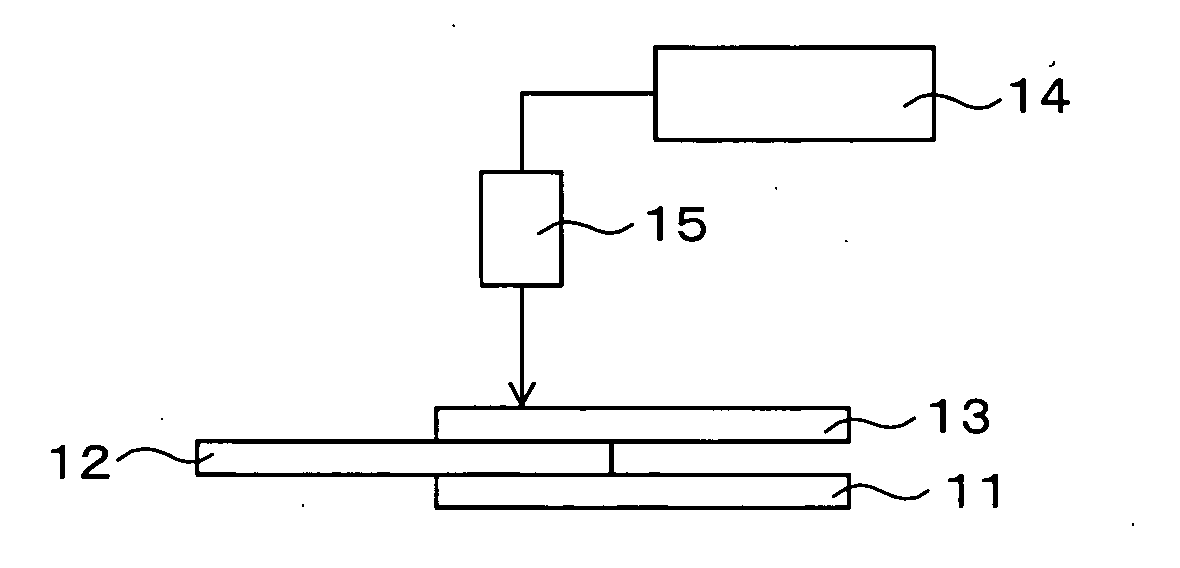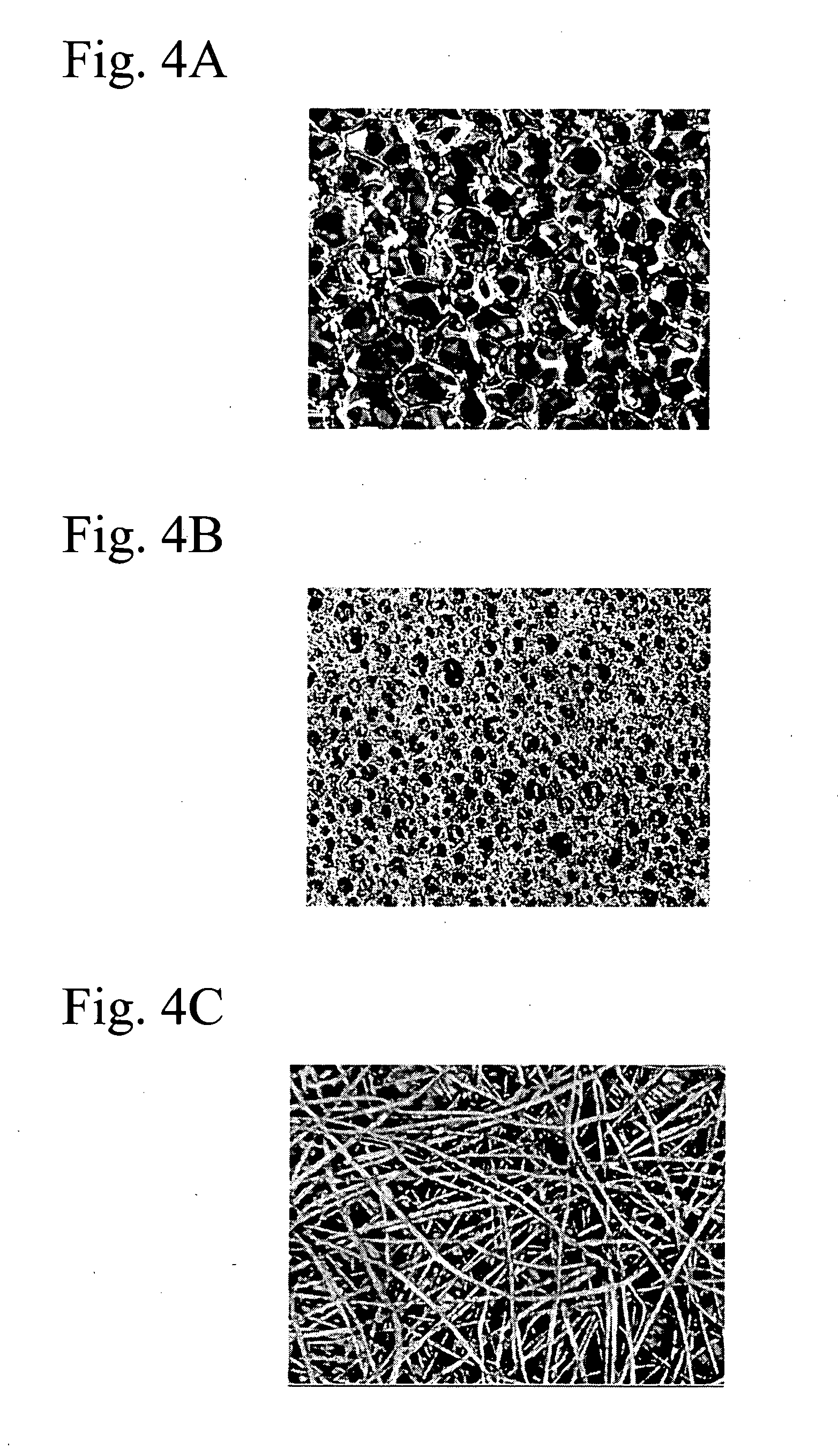Method for joining laser transmitting resin member and porous member, method for joining thermoplastic resin, and fuel cell
a technology of laser transmitting resin and porous material, which is applied in the direction of cell components, cell component details, electrochemical generators, etc., can solve the problems of deteriorating the airtightness of the cell, affecting the efficiency of the cell, so as to achieve easy laser joining, low production cost, and easy warpage and swelling
- Summary
- Abstract
- Description
- Claims
- Application Information
AI Technical Summary
Benefits of technology
Problems solved by technology
Method used
Image
Examples
example 1
PRACTICAL EXAMPLE 1
[0209] As to the joining form shown in FIG. 9, metallic foam shown in FIG. 4B is used as the porous member 31, PEEK is used as the laser transmitting resin member 32, and a laser beam is emitted from above in FIG. 9 so that they are joined. FIG. 12A is a cross sectional view illustrating a joined body obtained in such a manner, and FIG. 12B is a vertical sectional view illustrating the joined body. As is clear from FIG. 12A, pores with diameter of 20 to 50 μm formed by the metallic foam are sufficiently impregnated with the resin. As is clear from FIG. 12B, although residual pores (white portions in the drawing) are present in the joined body, the pores are sufficiently impregnated with the resin in the thicknesswise direction. As a result, the peel strength of the joined body shown in FIGS. 12A and 12B is sufficiently three-dimensionally secured.
EMBODIMENT OF THE THIRD TO THE SIXTH ASPECTS OF THE INVENTION
[0210]FIG. 13 is a conceptual diagram illustrating one p...
example 2
PRACTICAL EXAMPLE 2
[0237] A Practical Example of the invention is explained in detail below, and the effects of the present invention are substantiated.
[0238]FIG. 24 is a conceptual diagram illustrating a resin joining form for substantiating the effects of the present invention. As shown in FIG. 24, laser transmitting thermoplastic resins 311 and 312 and a laser absorbing thermoplastic resin 313 are laminated, and a laser beam with wavelength of 940 nm is emitted from above in a direction of an arrow 314. The joined states of predetermined places 315 and 316 of the interfaces between the resins 311 to 313 are determined. Laser transmission efficiency of the laser transmitting thermoplastic resins 311 and 312 is 15.9%, their melting points are 282° C., and specific heat at constant pressure at 282° C. is 1.8 kJ / kg·K, a target value of the melting thickness is 0.19 mm, and specific gravity is 1.77 g / cm3.
[0239] In this Practical Example, the joined states in Experimental examples 1 ...
example 3
PRACTICAL EXAMPLE 3
[0241] As shown in FIG. 25, the laser transmitting thermoplastic resins 317 and 318 are laminated, laser with wavelength of 940 nm is emitted from above to a direction of an arrow 319 under the same conditions as those in the Experimental Example 6 where the preferable results are obtained in the Practical Example 2 (see corresponding portions in Table 1). The joined state of a predetermined place 320 of the interface between the resins 317 and 318 is determined as a confirmation work. The laser transmission efficiency of the laser transmitting thermoplastic resins 311 and 312 is 15.9%, and their melting point is 282° C., specific heat at constant pressure at 282° C. is 1.8 kJ / kg·K, a target value of the melting thickness is 0.19 mm, and specific gravity is 1.77 g / cm3.
[0242] As a result, it is confirmed that the joined state is satisfactory, and thus as shown in FIG. 25, even in the case where the laser absorptive thermoplastic resin is not laminated on the botto...
PUM
| Property | Measurement | Unit |
|---|---|---|
| viscosity | aaaaa | aaaaa |
| thickness | aaaaa | aaaaa |
| diameter | aaaaa | aaaaa |
Abstract
Description
Claims
Application Information
 Login to View More
Login to View More - R&D
- Intellectual Property
- Life Sciences
- Materials
- Tech Scout
- Unparalleled Data Quality
- Higher Quality Content
- 60% Fewer Hallucinations
Browse by: Latest US Patents, China's latest patents, Technical Efficacy Thesaurus, Application Domain, Technology Topic, Popular Technical Reports.
© 2025 PatSnap. All rights reserved.Legal|Privacy policy|Modern Slavery Act Transparency Statement|Sitemap|About US| Contact US: help@patsnap.com



